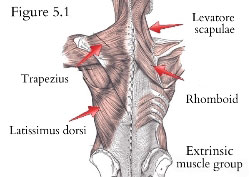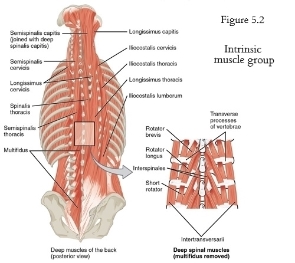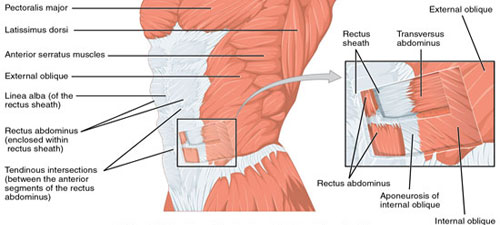Your Back and Abdominal Muscles
The dangers of muscle spasms and guarding
Sherwin Nicholson | Updated May 4, 2020
Your back muscles divide into two groups. Extrinsic and intrinsic. Within each group, they arrange symmetrically along either side on your spine in a mirror-like fashion with the corresponding muscles on each side.
Extrinsic and Intrinsic Muscles
Throughout the day, as you stand, they are constantly active and firing to help you stay upright. You normally are not aware of this unless you have a back spasm.
The extrinsic group is responsible for upper extremity (arm and hand) and shoulder movement. The intrinsic group is responsible for any movement of your vertebral column. They are observed in a
 V-shape, as you can see their shape from behind in a mirror.
V-shape, as you can see their shape from behind in a mirror.
As seen in figure 5.1., they are the: trapezius, latissimus dorsi, levator scapulae and rhomboids.
Other extrinsic muscles are the: serratus posterior inferior and superior. Their function is to help you to breathe.
Intrinsic muscles (Figure 5.2) are the small and firm muscles that travel along each of your vertebra from the pelvis to the cranium. It is these ones that can be strained and fatigued and lead to your pain and spasms. When you lift improperly or use poor posture, you can cause injury to this group.

The intrinsic group has three layers
The first layer consists of the: rotatores, multifidus and the semispinalis.
It is this deep layer that runs along your spine. It connects each vertebra responsible for your alignment and posture.
The deep layer helps to keep you upright and works to maintain proper posture.
Throughout the day, as you stand, they are constantly active and firing to help you stay upright. You normally are not aware of this unless you have a back spasm.
These deep muscles are short and dense. They connect and travel from one particular bony origin on the vertebrae to the next vertebrae. There are several of these on every vertebra.
It is important that the muscles of each vertebra are balanced and equal in strength or there will be a misalignment in your spine.
A misalignment can result in over-correction and overcompensation from other groups and trigger a back spasm to prevent further serious injury.
Figure 5.1 illustrates the groups involved in your backs’ movement and posture. These muscles are the smallest of the three groups.
The second layer are the erector spinae. They’re larger and shaped like straps. Instead of joining vertebrae to vertebrae, they join from the vertebrae to other areas of your body. This includes the head, rib cage and pelvis. Their purpose is to ensure that you maintain a stable posture that extends down your vertebral column.
The third and largest layer is what connects your shoulder blades and joints to your spine. These muscles are the largest and strongest. Whenever you lift, they work to keep your trunk stable to protect your vertebrae.
The muscles within the second and third groups help to contract to hold the correct curvature of your spine so that it can bear a load safely and balanced. This is done as the larger groups of the rest of the body exert force as in lifting.
Muscle Spasms and Guarding
When you have a back spasm, sometimes the deep layer is not firing with the proper timing and duration. They become fatigued or underused from poor conditioning such as sitting. When this happens, the other layers of your back begin to compensate and try to take over the job of the deep layer.
Because they are not able to perform at the same ability and duration, they consequently fatigue. The deep layer shut down and no longer perform their primary function. The outer layer then fatigues and can progress into a strain or sprain.
This occurs during a back spasm as the outer layers of the back freeze in order to protect the deeper ones and consequently the spine. This phenomenon is known as “guarding”. It is very unpleasant and painful when it occurs in larger muscles, and most people are likely to resort to pain medication and relaxants.
When a muscle or a group of them, guard a particular area such as a joint or disc space, sometimes the area is no longer stable as the guarding locks the joint into a new but compromised position.
The deeper muscles that were protected by the outer layer have fixed into a new position and misalignment. Now you have an imbalance of strength and length that remains even if the pain subsides.
Guarding creates a risk to your discs or nerves and perpetuates an additional problem in a cycle of pain and injury. Most of the time, you cannot sense that you’re out of alignment and will likely continue to perform daily activities. You might even assume that your back has recovered and risk re-injury. This causes the guarding to become worse and may exacerbate further misalignment and pain.
Your Abdominals
The abdominals (Figure 5.3) such as the Rectus abdominus (six pack) help to balance out the constant flexing of your back.
They  contract and draw your upper body down toward the hips. When you contract your abdominals, you produce a pressurized cavity that helps your to relieve any weight put on the spine. Doing the helps you to protect your discs during a lift or with most posture.
contract and draw your upper body down toward the hips. When you contract your abdominals, you produce a pressurized cavity that helps your to relieve any weight put on the spine. Doing the helps you to protect your discs during a lift or with most posture.
It is important that you keep your abs active during times of lifting because they maintain the normal curvature and help your to prevent disc injury. Weak or unconditioned abdominals are prone to back injury because of this imbalance.
Your other vital abdominal muscles include the internal and external obliques and the transverse abdominus. The transverse abdominus is the ‘corset’ that surrounds and contains the abdominal cavity. Whenever you contract it, you help to provide a sustained upward force to relieve pressure on your spine.
This is important for everyday daily tasks where lifting is required. If you have very weak and unresponsive abdominals you may notice an excessive anterior pelvic tilt. Any time that your pelvic tilt is out of neutral, you risk injury to your lumbar spine and disc, causing pain.
Avoid the risks involved with muscle imbalances, spasms, guarding and improper lifting by following these comprehensive, step by step, lower back exercises. They will recondition and strengthen your back and abdominals so that you will be protected. You’ll learn how to safely protect your spine and pelvis from disc injury and lower back pain.
For more help with your back and abdominals:
Follow this exercise to relieve your anterior pelic tilt pain
Don’t let your back freeze up on you
Try these important exercises to relieve your back problems
References:
- Lower back pain – Eric R. Castillo Daniel E. Lieberman Evol Med Public Health (2015) 2015 (1): 2-3. DOI: https://doi.org/10.1093/emph/eou034 Published: 10 January 2015 https://academic.oup.com/emph/article
- General information-Fact Sheet-NIH-http://www.ninds.nih.gov/disorders/backpain/detail_backpain.htm
- End Back Pain & Neck Pain – Fortanasce, Vincent. 2012. 617.564For . Human Kinetics c2012.
- Solving Back Problems – Dr. J. Sutcliffe. Timelife Custom Publishing. Health Fact File. 1999. RD768S82
